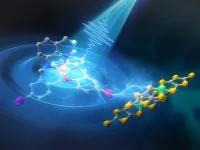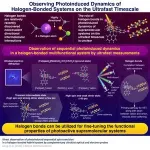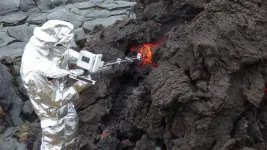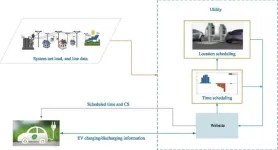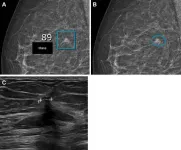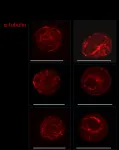(Press-News.org) Researchers uncover how the halogen bond can be exploited to direct sequential dynamics in the multi-functional crystals, offering crucial insights for developing ultrafast-response times for multilevel optical storage.
Halogen bonds are intermolecular interactions that arise from the attraction between a halogen atom (group 17 elements in the periodic table) and another atom with lone pairs, more generally a molecular entity with high electron density. Understanding the distinctive and highly directional nature of halogen bonds is crucial for crystal engineering and studying photoinduced structural deformations, which is key for the development of innovative photo-functional materials.
However, the influence of halogen bonds on the rapid photoinduced changes within supramolecular systems remains largely unexplored due to a lack of experimental techniques that can directly observe the halogen bond in action.
To solve this problem, a team of researchers, led by Assistant Professor Tadahiko Ishikawa from the Department of Chemistry at the School of Science at Tokyo Institute of Technology (Tokyo Tech), Associate Professor Kazuyuki Takahashi affiliated with Kobe University, Dr. Yifeng Jiang affiliated with the European X-Ray Free-Electron Laser Facility (EuXFEL), and Professor R. J. Dwayne Miller affiliated with University of Toronto, explored the photoinduced dynamics associated with the halogen bonds of the prototypical halogen-bonded multifunctional system [Fe(Iqsal)2][Ni(dmit)2]·CH3CN·H2O on the ultrafast timescale, triggered by change in electron spin or spin crossover (SCO) mechanics. The study, which is a collaborative research project involving Tokyo Tech, EuXFEL, University of Potsdam, University of Toronto, University of Tsukuba, and Kobe University, has been detailed in the journal Nature Communications.
SCO is a phenomenon observed in some transition-metal coordination complexes, wherein a spin transition between low-spin (LS) and high-spin (HS) states is triggered through changes in temperature, pressure, or light. SCO accompanies relatively large volume changes and can be controlled by photoinducing different responses in the multifunctional crystals. [Fe(Iqsal)2][Ni(dmit)2]·CH3CN·H2O is a typical example of such multifunctional crystals, which exhibits both thermally- and photo-induced SCO-related phase transitions. In this system, [Fe(Iqsal)2]+ cations and [Ni(dmit)2]– anions are bound by halogen bonds.
“SCO of the [Fe(Iqsal)2]+ cations leads to a phase transition between low-temperature (LT) and high-temperature (HT) phases in our target material due to intermolecular interactions,” explains Ishikawa. “The LT phase exhibits LS state of the [Fe(Iqsal)2]+ cations and strong dimerization of the [Ni(dmit)2]– anions, while the HT phase exhibits HS state cations and weak dimerization of anions. The question is how does the halogen bond direct electron density and spin changes to impact functions as part of undergoing these phase transitions. Can we control the phase and material properties?”
The researchers investigated the ultrafast photoinduced molecular dynamics involving SCO of the [Fe(Iqsal)2]+ cations and dimerization of the [Ni(dmit)2]– anions by combining three methods: time-resolved transient visible absorption spectroscopy, time-resolved mid-infrared reflectivity spectroscopy, and ultrafast electron diffraction to study the dynamics from different viewpoints, covering electronic, vibrational, and structural aspects of the system. This comprehensive approach allowed for a thorough investigation of the photoinduced change of the states, providing a deeper understanding of the underlying processes and intermediates involved. They discovered the existence of a photoinduced transient intermediate state (TIS) different from the LT and HT phases, characterized by the HS state of [Fe(Iqsal)2]+ cations with strong dimerization of [Ni(dmit)2]– anions. This TIS state is achieved in the ultrafast timescale, within a few picoseconds, while the final state, similar to the HT phase, is achieved through sequential slow dynamics over approximately 50 picoseconds.
Furthermore, to elucidate the role of the halogen bonds in the above-mentioned photoinduced sequential dynamics, the researchers conducted quantum chemistry calculations using the ultrafast electron diffraction results. Their analysis revealed the persistence of halogen bonds between the cation and the anion guiding the sequential dynamics. Photoexcitation of the [Fe(Iqsal)2]+ cation expands the SCO ligand shell, reaching TIS. This state, being unstable, transfers the excess energy of the [Fe(Iqsal)2]+ cation to the [Ni(dmit)2]– anions through vibrational energy transfer via halogen bonds. In addition, the rapid expansion of the SCO ligand shell builds strain on the nearest [Ni(dmit)2]– anions in the halogen bond direction. These two effects result in dimer softening of the [Ni(dmit)2]– anions. The researchers developed a short video to illustrate these ultrafast dynamics.
Overall, the present results underscore the importance of halogen bonds in the photoinduced dynamics, offering a better understanding of the synergistic spin transition. “Our study highlights the importance of ultrafast investigations in monitoring ultrafast electronic and structural dynamics,” remarks Jiang. “Overall, our study highlights the potential for utilizing halogen bonds for fine-tuned functional control in photo-active supramolecular systems, with applications in fast multilevel optical data storage.”
###
About Tokyo Institute of Technology
Tokyo Tech stands at the forefront of research and higher education as the leading university for
science and technology in Japan. Tokyo Tech researchers excel in fields ranging from materials
science to biology, computer science, and physics. Founded in 1881, Tokyo Tech hosts over 10,000
undergraduate and graduate students per year, who develop into scientific leaders and some of the
most sought-after engineers in industry. Embodying the Japanese philosophy of “monotsukuri,”
meaning “technical ingenuity and innovation,” the Tokyo Tech community strives to contribute to
society through high-impact research.
https://www.titech.ac.jp/english/
END
Bottom Line: The U.S. Preventive Services Task Force (USPSTF) recommends exercise interventions to prevent falls in community-dwelling adults 65 years or older who are at increased risk for falls. The USPSTF recommends that clinicians individualize the decision to offer multifactorial interventions to prevent falls to community-dwelling adults 65 years or older who are at increased risk for falls. Existing evidence indicates that the overall net benefit of routinely offering multifactorial interventions to prevent falls is small. When determining ...
ABSTRACT 6006
CHICAGO ― According to preliminary data from a multi-institution Phase III trial led by researchers at The University of Texas MD Anderson Cancer Center, intensity modulated proton therapy (IMPT) achieved similar clinical outcomes and offered significant patient benefits when compared to traditional intensity modulated radiation therapy (IMRT) as part of chemoradiation treatment for patients with oropharyngeal (head and neck) cancer.
The results were presented today at the 2024 American Society of Clinical Oncology (ASCO) Annual Meeting by Steven Frank, M.D., professor of Radiation Oncology and executive director of the Particle ...
WASHINGTON, June 4, 2024 – Millions of people live near active volcanoes that are constantly monitored for signs of an impending eruption. When one occurs, scientists and governments rely on data to estimate the extent of the possible damage, informing evacuation plans and disaster response efforts. The nature of eruptions, unfortunately, means collecting data about them can sometimes be as challenging as organizing a response.
In Review of Scientific Instruments, by AIP Publishing, researchers from the University at Buffalo developed a tool for measuring the viscosity of lava that could increase our understanding of molten rock as well as better improve ...
About The Study: This population-based cohort study of men with prostate cancer suggests that higher county-level prevalence of prostate-specific antigen (PSA) screening was associated with lower odds of advanced disease, all-cause mortality, and prostate cancer–specific mortality. Associations varied by age, race and ethnicity, and U.S. Census region.
Corresponding Author: To contact the corresponding author, Hari S. Iyer, Sc.D., M.P.H., email hari.iyer@rutgers.edu.
To access the embargoed study: Visit ...
About The Study: This nonrandomized controlled trial found that compared with usual care alone, partnership with a trained psychiatric service dog was associated with lower posttraumatic stress disorder (PTSD) symptom severity and higher psychosocial functioning in veterans. Psychiatric service dogs may be an effective complementary intervention for military service–related PTSD.
Corresponding Author: To contact the corresponding author, Marguerite E. O’Haire, Ph.D., email maggieohaire@arizona.edu.
To access the embargoed study: Visit our For The Media website at this link https://media.jamanetwork.com/
(doi:10.1001/jamanetworkopen.2024.14686)
Editor’s ...
In response to the escalating demand for sustainable transportation solutions, researchers from the National Institute of Technology Silchar have developed a groundbreaking scheduling system for electric vehicles (EVs) that enhances power grid efficiency and accommodates the growing influx of solar energy. This advanced system, outlined in a recent study by Pritam Das and Partha Kayal, focuses on optimizing the charging and discharging times of EVs to better integrate with photovoltaic (PV) energy ...
OAK BROOK, Ill. – Using artificial intelligence (AI), breast radiologists in Denmark have improved breast cancer screening performance and reduced the rate of false-positive findings. Results of the study were published today in Radiology, a journal of the Radiological Society of North America (RSNA).
Mammography successfully reduces breast cancer mortality, but also carries the risk of false-positive findings. In recent years, researchers have studied the use of AI systems in screening.
“We believe AI has the potential to improve screening performance,” said Andreas D. Lauritzen, Ph.D., a post-doctoral student at the University of Copenhagen and researcher ...
A new study by Carnegie Mellon University researchers found that when roboticists and people with disabilities collaborate on robot designs, interesting ideas emerge that could make existing robots more accessible and inspire new uses.
In their research, School of Computer Science faculty members Sarah Fox and Nikolas Martelaro highlight potential issues sidewalk robots encounter during deployment and propose solutions to mitigate them before the robots hit the streets. Their new study, led by Human-Computer Interaction Institute (HCII) Ph.D. student Howard Han, was presented last month at the ACM Conference on ...
A new study by Florida Atlantic University’s Schmidt College of Medicine has uncovered a disturbing trend in drug-related infant deaths in the United States from 2018 to 2022.
Infant deaths are those that occur between the time a child is born and age 1. Drug-involved deaths are those in which drugs are either the primary cause of death or a contributing factor and may occur due to maternal drug use, inadvertent or accidental intake of specific prescriptions, illicit or non-medical use of drugs and other incidents where drugs were linked to death.
Results of the study, published in the Journal of Perinatal Medicine, show that in the U.S. from 2018 to 2022, drug-involved ...
Scientists at Duke-NUS Medical School have identified how the first domino falls after a person encounters an allergen, such as peanuts, shellfish, pollen or dust mites. Their discovery, published in the April issue of Nature Immunology, could herald the development of drugs to prevent these severe reactions.
It is well established that when mast cells, a type of immune cell, mistake a harmless substance, such as peanuts or dust mites, as a threat, they release an immediate first wave of bioactive chemicals against the perceived threat. When mast cells, which reside under the skin, around blood vessels and in the linings of the airways and the gastrointestinal tract, simultaneously release ...
